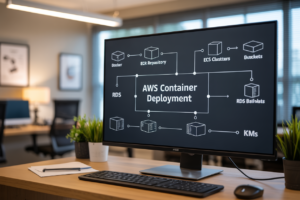Are you struggling with sky-high AWS compute costs? 😰 You’re not alone. Many businesses find themselves drowning in cloud expenses, watching their budgets spiral out of control. But what if we told you there’s a way to slash your AWS compute costs without sacrificing performance?
In this blog post, we’ll dive deep into cost optimization strategies for AWS compute services, including EC2, Lambda, Fargate, ECS, and EKS. We’ll uncover the secrets to right-sizing your instances, maximizing efficiency, and streamlining your operations. Whether you’re a startup trying to stretch every dollar or an enterprise looking to optimize at scale, these strategies will help you take control of your cloud spending.
From understanding the nuances of each AWS compute service to implementing cross-service optimization techniques, we’ll guide you through a comprehensive approach to cost management. Get ready to transform your AWS infrastructure into a lean, mean, cost-effective machine. Let’s explore how you can make the most of EC2 instances, supercharge your Lambda functions, optimize Fargate deployments, streamline ECS cluster management, and run cost-effective EKS operations. 💪💻
Understanding AWS Compute Services
A. EC2: Flexible virtual servers
Amazon Elastic Compute Cloud (EC2) offers scalable computing capacity in the AWS cloud. EC2 instances provide:
- Customizable configurations
- Pay-as-you-go pricing
- Integration with other AWS services
Key features of EC2:
- Instance types optimized for different use cases
- Multiple pricing options (On-Demand, Reserved, Spot)
- Auto Scaling for dynamic workloads
- Amazon Machine Images (AMIs) for quick deployment
| Instance Family | Use Case |
|---|---|
| General Purpose | Balanced compute, memory, and networking |
| Compute Optimized | High-performance computing, batch processing |
| Memory Optimized | Large-scale, in-memory applications |
| Storage Optimized | High I/O workloads, data warehousing |
| GPU Instances | Machine learning, graphics rendering |
B. Lambda: Serverless functions
AWS Lambda enables running code without provisioning or managing servers. Benefits include:
- Automatic scaling
- Pay only for compute time consumed
- Support for multiple programming languages
Lambda is ideal for:
- Microservices architecture
- Real-time file processing
- Backend for web and mobile applications
C. Fargate: Serverless containers
AWS Fargate is a serverless compute engine for containers that works with both Amazon ECS and EKS. Advantages of Fargate:
- No server management required
- Pay-per-task pricing model
- Seamless integration with other AWS services
Use cases for Fargate:
- Microservices deployments
- Batch processing
- Application migrations to containers
D. ECS: Container orchestration
Amazon Elastic Container Service (ECS) is a fully managed container orchestration service. Key features:
- Support for Docker containers
- Integration with AWS services
- Task definitions for application components
ECS deployment options:
- EC2 launch type
- Fargate launch type
E. EKS: Managed Kubernetes
Amazon Elastic Kubernetes Service (EKS) provides a managed Kubernetes platform. Benefits of EKS:
- Simplified Kubernetes deployment and management
- Integration with AWS networking and security services
- Support for both EC2 and Fargate compute
EKS is suitable for:
- Large-scale container deployments
- Hybrid cloud architectures
- Organizations with existing Kubernetes expertise
Now that we’ve covered the various AWS compute services, let’s explore strategies for right-sizing EC2 instances to optimize costs and performance.
Right-sizing EC2 Instances
Analyzing resource utilization
To effectively right-size your EC2 instances, start by analyzing your resource utilization. AWS provides powerful tools like CloudWatch and Trusted Advisor to help you gather crucial metrics. Focus on CPU, memory, network, and disk I/O usage patterns over time.
- Key metrics to monitor:
- CPU utilization
- Memory usage
- Network throughput
- Disk I/O operations
Use these insights to identify underutilized or overprovisioned instances, allowing you to make data-driven decisions for optimization.
Choosing optimal instance types
Once you’ve analyzed your resource utilization, select the most suitable EC2 instance types for your workloads. AWS offers a wide range of instance families optimized for different use cases.
| Instance Family | Optimized For | Use Case |
|---|---|---|
| T3 | Burstable performance | Web servers, dev environments |
| M5 | General purpose | Application servers, small databases |
| C5 | Compute-optimized | High-performance computing, batch processing |
| R5 | Memory-optimized | In-memory databases, real-time analytics |
| I3 | Storage-optimized | Data warehousing, high-speed I/O applications |
Consider using AWS Compute Optimizer for tailored recommendations based on your specific workload patterns.
Leveraging auto-scaling groups
Implement Auto Scaling groups to automatically adjust the number of EC2 instances based on demand. This ensures you have the right number of instances to handle your application load while minimizing costs.
- Benefits of Auto Scaling:
- Improved availability
- Cost optimization
- Automatic resource management
- Seamless scalability
Configure scaling policies based on metrics like CPU utilization or custom application-specific metrics to fine-tune your scaling behavior.
Implementing scheduled scaling
For predictable workload patterns, use scheduled scaling to proactively adjust your EC2 capacity. This feature allows you to scale your instances based on time and date, aligning your resources with known traffic patterns or business hours.
Maximizing Lambda Efficiency
Optimizing function code
Efficient Lambda function code is crucial for cost optimization. Here are key strategies to maximize your Lambda function’s performance:
-
Minimize package size:
- Remove unnecessary dependencies
- Use lightweight frameworks
- Compress assets
-
Implement caching:
- Use global variables for reusable data
- Leverage /tmp directory for larger datasets
-
Optimize database queries:
- Use connection pooling
- Implement batch processing
| Optimization Technique | Impact on Performance | Impact on Cost |
|---|---|---|
| Minimize package size | Faster cold starts | Lower costs |
| Implement caching | Reduced execution time | Fewer invocations |
| Optimize DB queries | Improved throughput | Lower resource usage |
Managing concurrency
Effective concurrency management ensures optimal resource utilization and cost efficiency:
- Set concurrency limits to prevent unexpected spikes
- Use reserved concurrency for critical functions
- Implement retry mechanisms with exponential backoff
Adjusting memory allocation
Proper memory allocation directly impacts both performance and cost:
- Analyze CloudWatch logs to identify memory usage patterns
- Start with the minimum required memory and gradually increase
- Consider the trade-off between execution time and memory allocation
Utilizing provisioned concurrency
Provisioned concurrency can significantly reduce cold starts and improve performance:
- Use for functions with consistent, predictable workloads
- Configure based on expected traffic patterns
- Monitor and adjust provisioned concurrency levels regularly
By implementing these strategies, you can significantly improve your Lambda function’s efficiency and reduce costs. Remember to continuously monitor and optimize your functions as workloads and requirements evolve.
Optimizing Fargate Deployments
Rightsizing task definitions
Rightsizing task definitions is crucial for optimizing Fargate deployments and reducing costs. Start by analyzing your application’s resource requirements and adjusting CPU and memory allocations accordingly. Use tools like CloudWatch Container Insights to monitor resource utilization and identify areas for improvement.
| Resource | Optimization Strategy |
|---|---|
| CPU | Allocate based on average usage plus a buffer |
| Memory | Set according to application needs and avoid over-provisioning |
| Storage | Use ephemeral storage judiciously |
Consider the following best practices:
- Use smaller task sizes for better granularity and resource utilization
- Implement multi-container task definitions for efficient resource sharing
- Regularly review and adjust task definitions based on performance metrics
Implementing auto-scaling
Auto-scaling is essential for maintaining optimal performance while minimizing costs. Fargate supports both service-level and application-level auto-scaling, allowing you to dynamically adjust the number of tasks based on demand.
Key auto-scaling strategies:
- Set up target tracking scaling policies
- Implement step scaling for more granular control
- Use scheduled scaling for predictable workload patterns
Utilizing Spot capacity providers
Spot capacity providers offer significant cost savings for Fargate deployments. By leveraging Spot instances, you can reduce compute costs by up to 70% compared to On-Demand pricing. However, it’s important to design your applications to handle potential interruptions.
Best practices for using Spot with Fargate:
- Combine Spot and On-Demand capacity providers for reliability
- Implement proper error handling and retry mechanisms
- Use Spot Instance Interruption Notices to gracefully handle task terminations
By implementing these strategies, you can significantly optimize your Fargate deployments and achieve substantial cost savings while maintaining performance and reliability. Next, we’ll explore how to streamline ECS cluster management for further cost optimization.
Streamlining ECS Cluster Management
Optimizing cluster size
Optimizing your ECS cluster size is crucial for cost-effective operations. Start by analyzing your workload patterns and resource utilization to determine the ideal number of EC2 instances in your cluster. Use AWS CloudWatch metrics to monitor CPU, memory, and network usage, helping you identify peak times and idle periods.
| Metric | Description | Optimization Action |
|---|---|---|
| CPU Utilization | Percentage of CPU in use | Scale down if consistently low |
| Memory Usage | Amount of RAM consumed | Adjust instance types if mismatched |
| Network In/Out | Data transfer rates | Optimize for data-intensive tasks |
Consider implementing a mix of On-Demand and Spot Instances to balance reliability and cost savings. Spot Instances can offer up to 90% discount compared to On-Demand prices, making them ideal for fault-tolerant applications.
Implementing capacity providers
Capacity providers automate the management of infrastructure for your ECS tasks. They help maintain the desired number of instances and can scale your cluster based on demand. Two main types of capacity providers are:
- Auto Scaling Group (ASG) capacity provider
- Fargate capacity provider
Use ASG capacity providers for EC2-based tasks, allowing ECS to manage the underlying EC2 instances automatically. For serverless container deployments, leverage Fargate capacity providers to eliminate the need for managing EC2 instances altogether.
Leveraging task placement strategies
Task placement strategies optimize how ECS places tasks within your cluster. Choose from:
- Binpack: Places tasks on the least available amount of CPU or memory
- Random: Randomly places tasks across the cluster
- Spread: Evenly distributes tasks across the specified value
Implement a combination of these strategies to balance resource utilization and availability. For example, use binpack for cost optimization and spread for high availability.
Utilizing service auto-scaling
Service auto-scaling automatically adjusts the number of tasks in an ECS service based on CloudWatch metrics. This ensures you have the right number of containers running to handle your application load efficiently.
Set up auto-scaling rules based on:
- CPU utilization
- Memory usage
- Request count per target
By implementing these strategies, you can significantly streamline your ECS cluster management, leading to optimized resource utilization and reduced costs. Next, we’ll explore cost-effective EKS operations to further enhance your AWS compute cost optimization efforts.
Cost-effective EKS Operations
Optimizing node groups
Node groups are a critical component of EKS clusters, and optimizing them can lead to significant cost savings. To achieve this, consider the following strategies:
- Right-sizing nodes
- Implementing multi-AZ deployments
- Using mixed instance types
| Strategy | Benefits | Considerations |
|---|---|---|
| Right-sizing nodes | Reduces waste, improves resource utilization | Requires careful capacity planning |
| Multi-AZ deployments | Increases availability, balances costs | May increase network costs |
| Mixed instance types | Provides flexibility, optimizes costs | Requires more complex management |
Implementing cluster autoscaler
The cluster autoscaler is a powerful tool for managing EKS costs. It automatically adjusts the number of nodes in your cluster based on resource demands. Key benefits include:
- Automatic scaling of node groups
- Improved resource utilization
- Reduced manual intervention
Utilizing Spot instances
Spot instances can significantly reduce EKS costs, offering savings of up to 90% compared to On-Demand prices. To effectively use Spot instances:
- Implement instance diversification
- Use Spot instance interruption handling
- Combine with On-Demand instances for critical workloads
Managing add-ons efficiently
Efficient management of EKS add-ons is crucial for cost optimization. Consider these best practices:
- Regularly review and remove unused add-ons
- Optimize add-on resource requests
- Use AWS-managed add-ons when possible
By implementing these strategies, you can significantly reduce your EKS operational costs while maintaining performance and reliability. Next, we’ll explore cross-service optimization strategies to further enhance your AWS cost management efforts.
Cross-service Optimization Strategies
A. Implementing reserved instances
Reserved Instances (RIs) offer significant cost savings for predictable workloads across various AWS compute services. By committing to a specific instance type and region for a 1 or 3-year term, you can reduce costs by up to 72% compared to On-Demand pricing.
| Service | RI Benefits |
|---|---|
| EC2 | Up to 72% savings |
| RDS | Up to 69% savings |
| ElastiCache | Up to 55% savings |
| RedShift | Up to 76% savings |
To maximize RI benefits:
- Analyze usage patterns to identify stable, predictable workloads
- Choose the right RI type (Standard, Convertible, or Scheduled)
- Consider regional vs. zonal RIs based on your flexibility needs
- Use AWS Cost Explorer’s RI recommendations for data-driven decisions
B. Leveraging Savings Plans
Savings Plans offer flexibility across multiple compute services while providing significant discounts. Unlike RIs, Savings Plans allow you to commit to a specific dollar amount per hour, rather than instance types.
Key advantages of Savings Plans:
- Flexibility across EC2, Fargate, and Lambda
- Automatic application to eligible usage
- Up to 72% savings compared to On-Demand pricing
- Available in 1 or 3-year terms
To optimize Savings Plans:
- Use AWS Cost Explorer to analyze usage and receive recommendations
- Consider a mix of Compute Savings Plans and EC2 Instance Savings Plans
- Regularly review and adjust commitments based on changing workloads
C. Utilizing Spot instances across services
Spot Instances leverage unused EC2 capacity, offering discounts of up to 90% compared to On-Demand pricing. While primarily associated with EC2, Spot can be utilized across various AWS compute services.
| Service | Spot Integration |
|---|---|
| EC2 | Native support |
| ECS | Spot Fleet integration |
| EKS | Managed node groups with Spot |
| EMR | Spot Instances for task nodes |
Best practices for Spot usage:
- Use for fault-tolerant, flexible workloads
- Implement instance diversity to improve availability
- Utilize Spot Fleet for automated management
- Set up interruption handling mechanisms
D. Implementing proper tagging for cost allocation
Effective tagging is crucial for accurate cost allocation and optimization across AWS compute services. By implementing a comprehensive tagging strategy, you can easily track and manage costs for different projects, departments, or environments.
Key tagging best practices:
- Develop a consistent tagging policy across all services
- Use automated tagging tools like AWS Tag Editor
- Implement mandatory tags for cost allocation
- Regularly audit and update tags
Example tagging structure:
Project: ProjectName
Environment: Dev/Staging/Prod
Department: Marketing/Engineering/Finance
Owner: Username
CostCenter: CC12345
E. Monitoring and analyzing costs with AWS Cost Explorer
AWS Cost Explorer provides powerful tools for visualizing, understanding, and managing your AWS spending across all compute services. By leveraging its features, you can identify cost-saving opportunities and optimize your resource usage.
Key Cost Explorer features:
- Detailed cost breakdowns by service, account, and tag
- Custom reports and dashboards
- Forecasting capabilities for future cost estimation
- Rightsizing recommendations for EC2 instances
- Savings Plans and Reserved Instance recommendations
To maximize Cost Explorer benefits:
- Set up regular cost reports and alerts
- Use filters and groups to analyze specific cost areas
- Leverage the API for programmatic cost analysis
- Combine with AWS Budgets for proactive cost management
Now that we’ve explored cross-service optimization strategies, let’s recap the key points and discuss how to implement these strategies effectively in your AWS environment.
Implementing effective cost optimization strategies for AWS compute services is crucial for businesses looking to maximize their cloud investment. By right-sizing EC2 instances, fine-tuning Lambda functions, optimizing Fargate deployments, streamlining ECS cluster management, and running cost-effective EKS operations, organizations can significantly reduce their cloud spending without compromising performance. These targeted approaches, combined with cross-service optimization strategies, enable businesses to achieve a balance between cost-efficiency and operational excellence.
As you embark on your cost optimization journey, remember that it’s an ongoing process that requires continuous monitoring and adjustment. Regularly review your AWS usage, leverage automation tools, and stay informed about new features and pricing models. By adopting a proactive approach to cost management across your compute services, you’ll be well-positioned to scale your infrastructure efficiently and drive long-term success in the cloud.




















